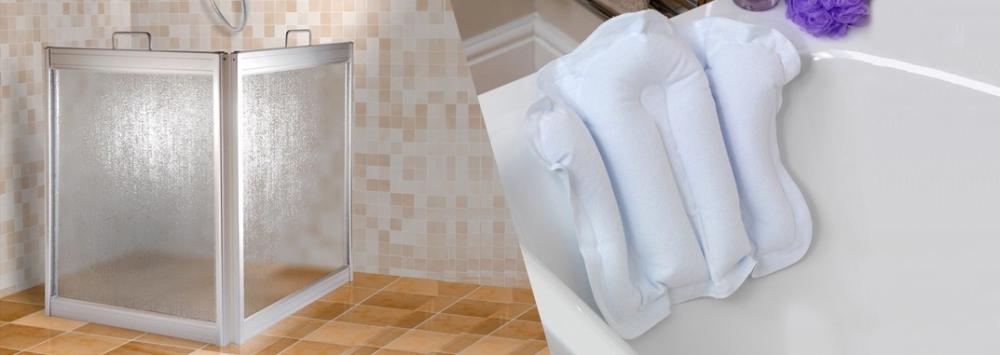
Age, Independence and Safety in the Bathroom
Sally Madeley-Carr, OT29 Oct 2021
Hygiene is an important part of our personal health regime.
Age, onset of arthritis, loss of energy and strength, mobility and dexterity changes, as well as major illnesses due to weakened immunity systems, can make everyday activities a struggle.
The bathroom is one of the two most dangerous rooms in a home (the kitchen is the other) and our senior years make it more difficult to feel safe in a bathroom.
Shaky hands and weakened grip, as well as unsteady balance and lack of mobility, will affect many tasks in the bathroom e.g. cleaning teeth, toileting, shaving, bathing and showering. Tailoring solutions to the individual's needs is paramount to overall safety and independence.
Depending on a senior's health issues, special aids and adaptations should be identified to keep bathing or showering as independent and safe a task as possible.
Changes in eyesight can also present difficulties.
Staying Safe
Possible risks in a bathroom include:-
- locking oneself in the bathroom
- falling because of a weakened frame e.g. unsteady balance, or general weakness due to illness
- slipping on a wet floor
- being unable to stand from a seated position e.g. after toileting
- falling in the shower after standing for too long a period
- slipping when entering or exiting the bath or shower
- not recognising how hot the water is on the skin.
- Locking Oneself In
Privacy is a human expectation, particularly during self care in a bathroom.
Locking the bathroom door is a natural thing to do and expect.
-Solutions
A double-sided lock will allow the individual to have the promise of privacy, with the inbuilt safety element of help being at hand in an emergency.
- Falling
Age brings instability and falling does happen. Knocking against a hard surface (e.g. the corner of a wash hand basin or pillow for bathtub) may cause bleeding and even unconsciousness.
-Solutions
Place grab rails in appropriate places and close enough together to allow the individual to hold another grab rail before letting go of the other.
Depending on the size of the bathroom, a walking frame could give support to the individual, if there is enough turning space available.
- Slipping on a Wet Floor
Washing, as well as shaving, at the wash hand basin can make the floor wet.
Stepping out of a bath or shower can leave quite a lot of water on the floor. Slipping could cause broken bones, as well as damage to any part of the body in the resulting fall.
-Solutions
Choose floor tiles which have rough, rather than shiny, surfaces, to reduce the chance of slipping.
Stone tiles absorb spilt water, reducing the likelihood of slipping.
Grab rails will again prove useful in the bath / shower (entering and exiting) and immediately outside the bath / shower, to steady the user during changing location and to hold onto whilst drying oneself, or preparing to sit down.
- Being Unable to Stand from a Seated Position
Rising from a seated position on the toilet can be a challenge for people with balance problems or weakened frames. Weakened grip can also contribute to the difficulty.
-Solutions
The average toilet has a height of 17 inches (42.5 cms.) and it is possible to purchase toilets with a height of 20 inches (50 cms.) and 21 (52.5 cms.) inches. This extra height makes it easier to get into a standing position.
An extra thick toilet seat can also give extra height, making standing a little easier.
A shower chair with wheels can fit around the toilet bowl. Some designs have a hole cut out of the shower chair seat, so that toileting can be done from there.
Appropriately placed grab rails will steady the individual when getting into a standing position.
- Falling in the Shower after Standing for too Long a Period
Falling in a shower could lead to banging one's head and upper body against the shower screen and possibly breaking bones.
-Solutions
Appropriately placed grab rails will give the individual the support needed when standing in a shower.
Using a shower seat will take the pressure off the legs and allow for a more pleasurable bathing experience.
A shower mat is a must, to give the user a firm footing with the wet shower base.
- Slipping When Entering or Exiting the Bath
Slipping when entering or exiting a bath could prove fatal.
-Solutions
The importance of grab rails can't be underestimated.
For bathing comfort, a bath board can be attached to the width of the bath, to allow for easy entry and exit.
For added safety, choose a bath board which can be locked into position.
A bath mat inside the bath is a must, to prevent the user slipping when getting in or out of the water.
- Not Recognising Water Temperature
Ageing can lead to thinner skin. Thinner skin + medication for some health conditions, as well as neurological damage, may lead to not recognising that water is too hot for the skin.
-Solutions
Fitting anti-scald mixing valves in the bathroom will eliminate the dangers of scalding and keep the individual safe whilst bathing or showering.
Bath, Shower, or Wet Room - Which is Safest?
When it comes to bathing or showering, for most of us, it's down to personal choice.
One can relax in a bath but cannot get the same 'sprawled' pleasure from time spent in a shower.
When health problems come into the picture, a bath or shower may not be a choice available to the individual. The following points may need to be addressed:-
- the individual who has epilepsy may feel safer in a shower; being unconscious from a seizure could prove fatal in a bath of deep water
- having a balance difficulty might rule out standing whilst showering
- climbing into a bath may prove unsafe for people with weakened frames, general weakness, poor grip and shakiness
- bathing can lead to splashed water finding its way to the floor, making slipping and falling likely
- a shower screen keeps water from the floor, as it acts like a barrier whilst showering or bathing
- if a shower is your choice, space within the bathroom may be needed for opening the shower screen outwards, to allow the individual to enter and exit the shower or shower-over-bath facility.
- Bath
Baths now come in different designs, shapes and sizes, including short, regular and long baths lengths, round baths, P-shaped baths and jacuzzis. Each has its own merits but all depends on the space available.
- Shower-Over Bath
By fitting a shower screen over the edge of the bath, the bath now twins as bath and shower.
A shower screen can be either one pane of glass, or a folding shower screen.
One pane of glass needs space within the bathroom to be opened outwards, for both entering and exiting the bath-cum-shower.
A folding shower screen needs less space than a single pane, as folding it reduces its width.
A sliding shower screen is two panes of glass which, when entering or exiting the bath-cum-shower, slide side by side next to each other.
- Shower
Standalone showers need not much more than a square metre of floor space.
With a full shower door, there will need to be another square metre free in front of the shower for the shower door to open to full capacity.
Some showers come with double panel bi-fold doors. Due to their folding ability, they need less clearance space in front of the shower unit.
- Wet Room
Wet rooms don't have a door and the floor is angled to go down slightly towards the back of the showering area, so as to keep used water flowing down the drain and not out of the front of the showering area.
Entry into a wet room doesn't have a risen floor to tackle and so the individual can enter the shower in a shower chair which has wheels, or in a wheelchair.
Eyesight Changes
With age as well as with disability, changes in our vision can make tasks take longer and be somewhat more difficult.
Colour contrast can play a big part in getting around e.g. white walls and blue towels. The contrast in colour makes identification easier.
Spotlights directed to important areas (e.g. the light switch, the toilet, the shower / bath and the wash hand basin) will make working in those areas more comfortable.
Light from above is less challenging than wall lights which can shine in one's face and cause discomfort.
Summary
Personal hygiene is paramount to good health.
For safety and security in the bathroom, take your health conditions into consideration for safe bathing and showering.
It is important that shower screens are made of thick, toughened, safety glass.
Quality glass looks good for longer.
Shower screens now come with handles, shelves and towel rails, making ergonomic use of the space available.
A folding shower screen allows more space to the individual for entering and exiting the bathing area.
Clean the glass after every use, to prevent soapy films building up and to keep the screen looking good for longer.
Consider fitting anti-scald mixing valves, to be certain that water doesn't become too hot for safe bathing / showering.
For elderly, infirm and disabled people, a double-sided lock makes a lot of sense, as seconds of delay with entry could change the outcome for the worse.
Ambient lighting is more comfortable to all.

Sally Madeley-Carr, OT
Sally qualified as an Occupational Therapist in 1996 and is a well-respected professional in the field of rehabilitation equipment and living aids. She has worked in private practice and within the NHS, developing a broad experience with adults and children. Click here for Sally's registration with the Health and Care Professions Council. The HCPC regulates health, psychological and social work professionals in the UK.